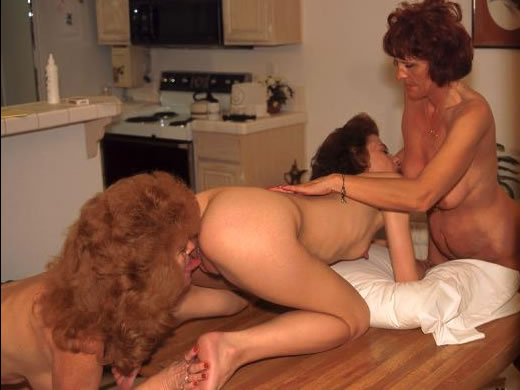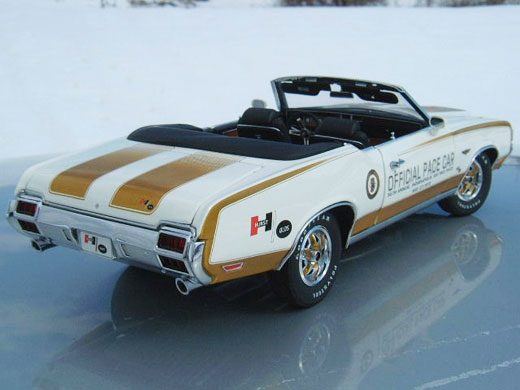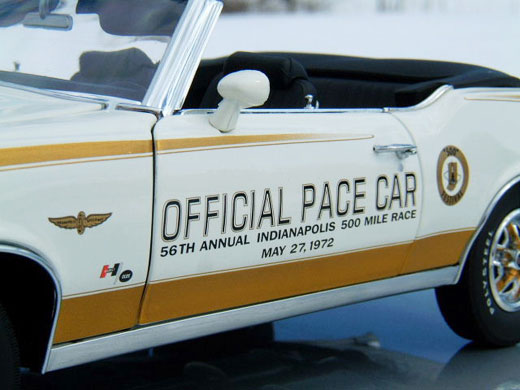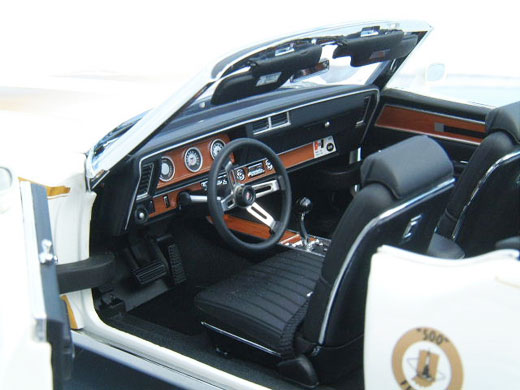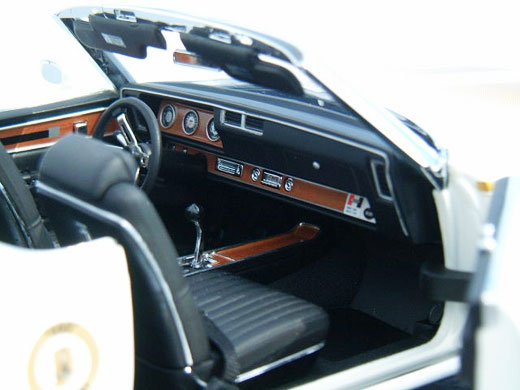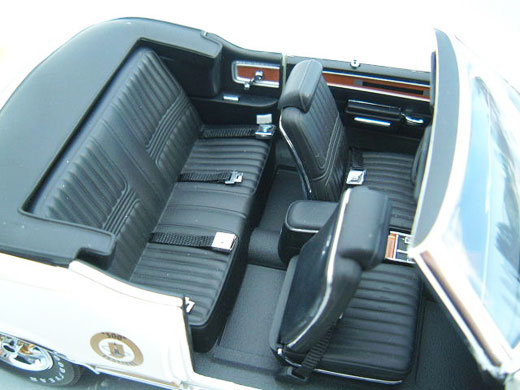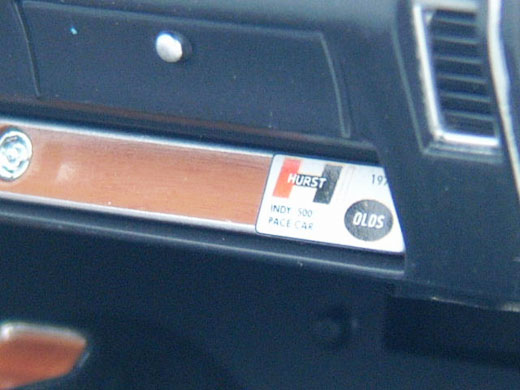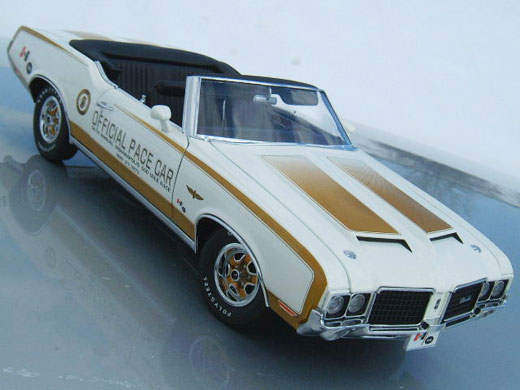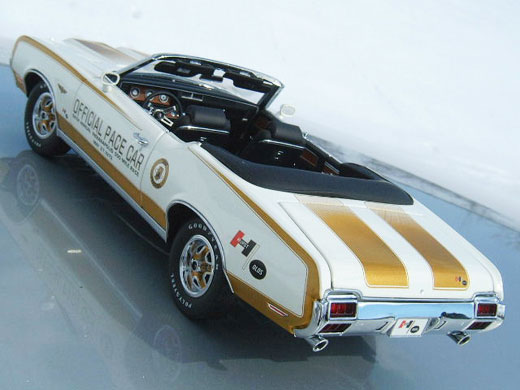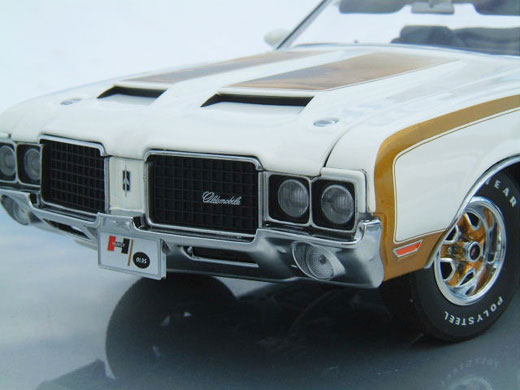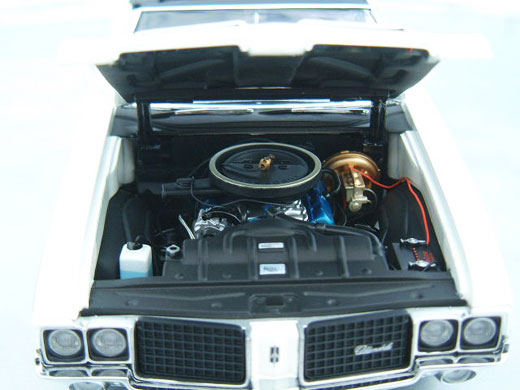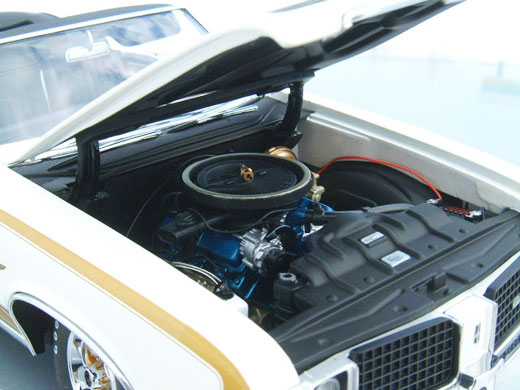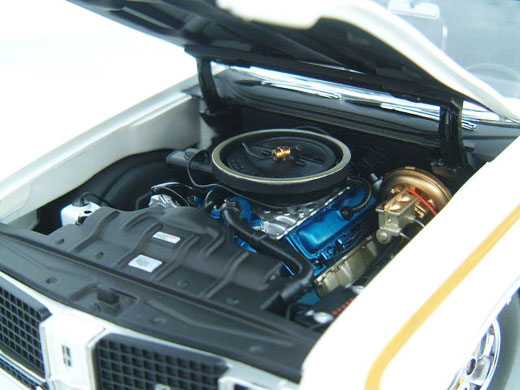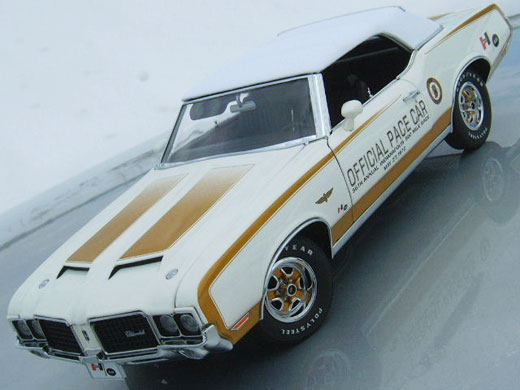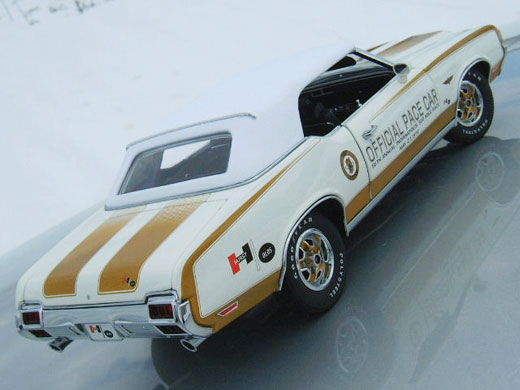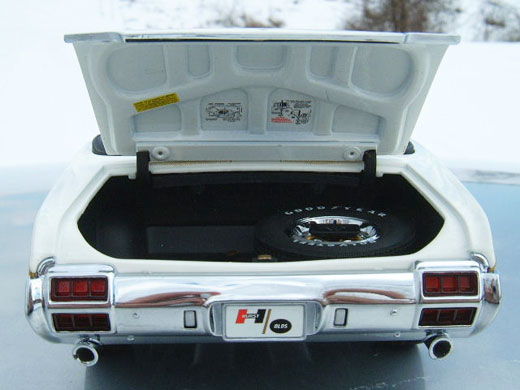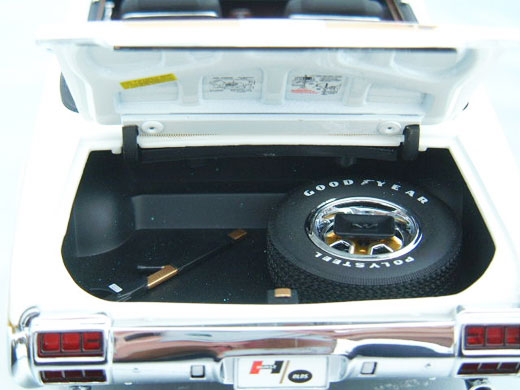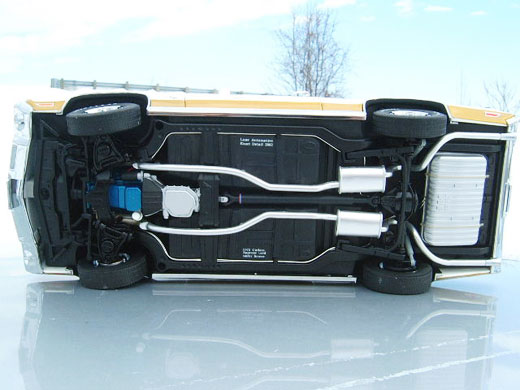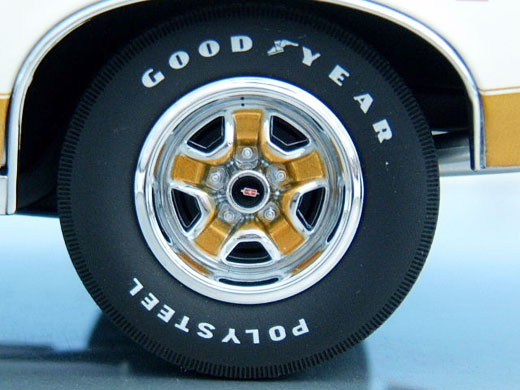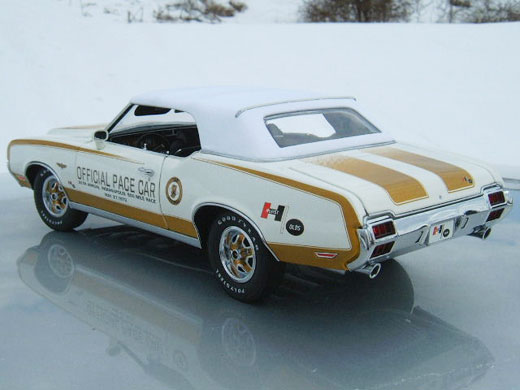|
|
 "Put one on your wanted list" read the colorful ad introducing the new Olds 4-4-2. The Olds 442 was born in 1964 strictly as an option on the GM A-body Olds F-85 Cutlass, coming in response to Pontiac's unveiling of the 64 Tempest based GTO. The age of the intermediate sized, large cubic-displacement engine muscle cars had been born and Oldsmobile was the first to join the movement next to Pontiac. For 1964 the Cutlass based 442 received a worked-over B-09 police pursuit package that incorporated a 290hp 330ci V8 mated to a 4 speed transmission, dual exhaust, and a dual snorkel air cleaner mounted over a 4-barrel carburetor that boosted the 442 to 310hp. In fact, it was these features that Oldsmobile derived the 4-4-2 moniker for its muscle machine. In 1964, 4-4-2 stood for 4-barrel carburetor, 4-on-the-floor shifter, dual exhaust. Even though the significance of the 1964 badge would change over the years, the name would remain the same. The 442 was received with such success that in 1968 it transcended its status as a Cutlass option to become a model all its own, bolstering its mark on the muscle car movement and becoming one of the most admired muscle cars of its era. "Put one on your wanted list" read the colorful ad introducing the new Olds 4-4-2. The Olds 442 was born in 1964 strictly as an option on the GM A-body Olds F-85 Cutlass, coming in response to Pontiac's unveiling of the 64 Tempest based GTO. The age of the intermediate sized, large cubic-displacement engine muscle cars had been born and Oldsmobile was the first to join the movement next to Pontiac. For 1964 the Cutlass based 442 received a worked-over B-09 police pursuit package that incorporated a 290hp 330ci V8 mated to a 4 speed transmission, dual exhaust, and a dual snorkel air cleaner mounted over a 4-barrel carburetor that boosted the 442 to 310hp. In fact, it was these features that Oldsmobile derived the 4-4-2 moniker for its muscle machine. In 1964, 4-4-2 stood for 4-barrel carburetor, 4-on-the-floor shifter, dual exhaust. Even though the significance of the 1964 badge would change over the years, the name would remain the same. The 442 was received with such success that in 1968 it transcended its status as a Cutlass option to become a model all its own, bolstering its mark on the muscle car movement and becoming one of the most admired muscle cars of its era.
In its nine years as a "true" muscle car, the 442 came in several different trim options, including unique body features, access to Oldsmobile's top engine options, and the best handling components. Critics claimed the Olds 442 was one of the most balanced of the intermediate sized muscle cars. Perhaps the most exciting option on the 442’s checklist and arguably the greatest impact to the 442’s performance image came in 1968 at the hands of George Hurst & Jack “Doc” Dixon of Hurst Performance. GM had a corporate wide ban that prohibited any engines larger than 400 cubic inches in displacement from being used in any intermediate sized car. But shifter mogul George Hurst had the idea of swapping out the 442’s 400 for a Toronado 455, resulting in a much quicker 442 that weighed less and handled just as well if not better than the standard 442. Dixon, Hurst’s right hand man, ran with the idea and further modified the 455, mated it to a Hurst Dual Gate shifter and wrapped it all up in a special paint scheme. The 68 Hurst/Olds was born.
Oldsmobile loved the idea, able to side step GM’s cubic inch ban, and began selling the 390hp 68 Hurst/Olds pavement pounders through their dealerships. Finished in Peruvian Silver with black side stripes & a black trunk, the 68 Hurst/Olds was a sleeper by definition, but by function it proved to be nothing short of beastly. Production of the 68 Hurst Olds started late in the model year, but Demmer Engineering was able to convert 515 442’s into Hurst/Olds blacktop blistering beasts in roughly 30 days. The 68 H/O was a huge success by any standard, paving the way for a long lasting relationship between Oldsmobile and Hurst Performance.
The Hurst/Olds tag team returned in 1969, and this time around, the sleeper-like exterior got a steroid injection to match the brute strength under its skin. The Hurst/Olds exploded out of its shell with a wild Cameo White and Hurst Fire Frost gold stripe scheme, along with a monster "mailbox" hood scoop and functional W35 fiberglass rear wing. The fiberglass hood-mounted scoop provided better airflow than the under-bumper scoops used in '68. While the horsepower output was down 10hp to 380, the 69 Hurst/Olds was still at the head of its class in performance while offering just about every option that was available on the 442, giving its owners a range of equipment and luxury options not equaled by many musclecars of the era. Fast and flashy, the 69 H/O is perhaps the most desirable of all the H/Os.
While the Hurst/Olds took a little time off after 1969, it had left an indelible mark on the Oldsmobile division, and it was no surprise that the 1970 Olds 442 W-30 was arguably the most potent of Oldsmobile’s non-Hurst 442’s. Oldsmobile’s 442 had reached a high point in its existence being honored as the 1970 Indy 500 Pace Car, a privilege extended to only those cars that represent the best in American automotive technology. Unfortunately, the party would be a short one, and in 1971, new government regulations mandating the use of unleaded fuel led to lower compression ratios, and a collaborative drop in horsepower ratings. Like it or not, 1971 was the beginning of the end for all muscle cars, and the 442 was in no way immune to these changes. Performance numbers plummeted & the 71 Olds 442 with the W-30 option 455 was down 70hp to 300 net horsepower. The writing was on the wall; the 442 was at its end as a standalone model & in 1972, the 442 would return to its roots, once again as an option on the Cutlass models.
The 442 may have seen its final act as a standalone road warrior after 1971, but destiny wouldn’t let the Oldsmobile Cutlass Supreme based 442 bow out without a bang. Dodge was the manufacturer of choice for the 1971 Indy Pace Car, but a pit lane accident would cast a shadow on the "The Greatest Spectacle in Racing" with manufacturer reluctance to participate in the Indy Pace Car program for the 1972 Indy 500. George Hurst stepped up to the plate with his 1972 Cutlass Supreme based Hurst/Olds featuring a 69 familiar paint scheme, the OAI W25 fiberglass dual scooped hood, and the 442 W-30’s 300hp 455 V8. Driven by Jim Rathmann, the 72 Hurst/Olds Indy Pace Car was significant for both Hurst & Oldsmobile. It marked the first time in Speedway history that an automotive parts manufacturer's name was included in the pace car title, and it was the second in four years that Oldsmobile served as the official pace car to the Indy 500 during the 1970's - more than any other manufacturer.
Shortly after 1972, Olds withdrew from making true muscle cars and the Hurst Olds cars quickly faded out. The Hurst/Olds relationship would live on for many years following 1972, but as nothing much more than a marketing tool used amidst Oldsmobile's lineup of government regulated environment friendly rag tag bunch of grocery-getters. The 1972 Hurst/Olds is revered by many muscle car enthusiasts as the last of a breed in a healthy lineage of great Oldsmobile muscle cars.
On a brighter note, the Hurst/Olds has made a grand encore in the form of a superbly detailed and masterfully replicated 1/18-scale diecast. The boys at Lane Collectibles have revisited their widely popular Exact Detail Oldsmobile diecast car series for another round of high detail delight, and this time they have brought us a beautiful copy of the 1972 Indy 500 Pace Car, the Hurst/Olds convertible. From the exterior box to the chrome plated door lock knobs, Lane has not skipped a beat on their latest Oldsmobile, offering over 240 unique parts and a beautiful presentation of authentic graphics. The box is decorated with Indy 500 logos along with graphics of the model replica as well as the actual car, and an informative history of the 72 Hurst/Olds 500 Pace Car including specifications of the real car. Inside the box, the 72 Hurst/Olds is encased in a styrofoam shell, keeping in all of that seemingly added new car "smell". How do they do that? The 1972 Hurst/Olds Indy Pace Car comes with a numbered certificate of authenticity & a black rubber boot cover along with a detailed white canvas top, both sealed atop the styrofoam shell. Like the previous 1970 Olds 442 Indy Pace Car, the 72 Husrt/Olds Pace Car convertible can be displayed in top up or top down fashion. Lane is manufacturing only 3,000 of the 1972 Hurst/Olds Pace Car, so this is not only a beautiful work of art, but one that is sure to be very rare in a short amount of time.
The '72 Hurst/Olds Indy 500 Pace Car is more than a work of art, it's another Lane Exact Detail diecast masterpiece, and with the color combination of the Cameo White exterior, gold stripes, and black interior, this masterpiece is simply stunning. For starters, the paint is very smooth and flawless over the entire car. The Cameo White paint is accented with Hurst authentic Fire Frost gold side & hood stripes that have a fade effect that is nothing short of mesmerizing. The race day graphics show nicely against the Cameo White background and have been applied evenly throughout with great precision. All of this has been sealed in a thin clear coat to prevent chips or scratches and it gives the Hurst/Olds a lustrous shine.
Lane has scored another bulls-eye with their outstanding job capturing the overall look & stance of the 1972 Hurst/Olds Pace Car. Inch for inch, they have recreated the Hurst/Olds accurately with great care & meticulousness, overlooking no details, no matter how insignificant. The W25 OAI fiberglass dual scooped hood has once again returned since its first emergence on the inaugural 70 Olds pace car and is detailed nicely with painted scoop openings, chrome plated hood-locking pins, and of course dual gold Hurst stripes with the authentic fade out effect. The chrome-plated bumpers are mirror-like and Lane has gone the extra mile and correctly captured the subtle differences in the 72 rear taillights, plus the unique black out grille of the 1972 Hurst/Olds. The rest of the 72 Hurst/Olds Pace Car is finished with chrome accents found around the headlights & grille area, along the top edge of the drivers & passenger side doors, and along the wheel well openings. As with the gold stripes & black interior, the chrome trim adds greatly to the richness of the milieu of the latest Lane Exact Detail Olds diecast model car.
Those familiar with previous Oldsmobile offerings from Lane will find nothing astonishingly new under the hood, in the interior or in the trunk, but those not familiar are in for a treat. The engine is a splendidly built replica of the Olds 455ci V8, resting among a miniature jungle of wires & hoses. Here you'll find heater hoses, radiator hoses, spark plug wires, plus a wired master cylinder with properly routed brake lines. The engine compartment is completed with a detailed firewall, black inner wheel wells, a detailed air cleaner lid, a detailed battery with battery cables, even a half empty washer fluid reservoir that has a miniature line running out of it. On the opposite end, the opening trunk is a little more organized than the engine bays wild kingdom of wires & hoses, but rightfully so. Inside the opening trunk, you'll find a spare gold painted Olds Rally wheel wrapped in an authentic Goodyear Polysteel tire, along with a jack and jacking instruction labels found on the underside of the trunk lid.
Upon opening the doors to the interior, you'll without a doubt notice the obsolete dogleg hinge design utilized on the Lane Exact Detail Oldsmobile diecast models, but you will find the overall beauty of the replicated interior to be so handsomely breathtaking that you will soon forget about that outdated hinge. (It is probably good to note that Lane has since adapted to using the new age, more realistic door hinge and is incorporating their deign on all future series offered in the Exact Detail lineup.) Inside Lanes 72 Hurst/Olds, you will discover some remarkable details from the labeled flip up sun visors, to the detailed dash with amazingly legible gauges, to the detailed door panels. The richly finished soft to touch black front buckets fold forward to a black soft to touch rear bench seat, both of which look every bit luxurious. The front seats are further enlightened with a rib of chrome plated trim along the base and back half of the seats. Both the bucket seats & the rear bench are further accented with woven seat belts & chrome plated belt clasps. The interior is capped off with a removable white canvas convertible top that can be replaced with a black rubber convertible boot. Add to that accurate 442 details including the custom sport 4 spoke steering wheel with brushed metal spokes and a Hurst Dual Gate shifter, along with a Hurst authentic H/O Indy Pace Car plaque located on the wood trimmed dash under the glove box, and you have the total package representative of the 1972 Hurst/Olds Indy Pace Car from Lane. Underneath the floorboards you'll find the Hurst Dual Gate shifter mated to an accurate reproduction of the Turbo Hydramatic tranny. Other notable details on the undercarriage include a detailed oil filter, detailed gas tank with painted straps, visible fuel & brake lines, detailed and functioning front & rear suspension parts, plus a stainless steel exhaust and muffler system that exits through a pair of chrome plated trumpet-style exhaust tips.
The Exact Detail 1972 Hurst/Olds Indy 500 Pace Car convertible from Lane Collectibles is, in the tradition of the previous Oldsmobile releases, another home run. This scale model is a perfect way to celebrate one of the last true Oldsmobile Cutlass based Hurst/Olds muscle cars, but with only 3000 copies built, it's sure to be a celebration that won't last long. Don't be left without one, be sure to "Put one on your wanted list".....Today!!
|
1972 Hurst Olds Pace Car, Lane ExactDetail
|
|
Total diecast model cars in 1972 Hurst Olds Pace Car, Lane ExactDetail: 0
|
|





